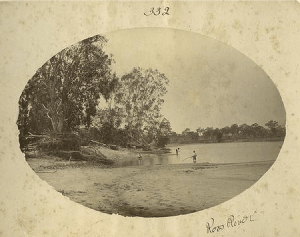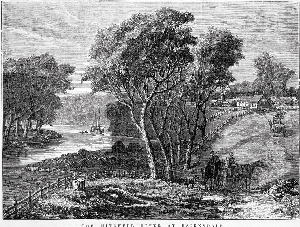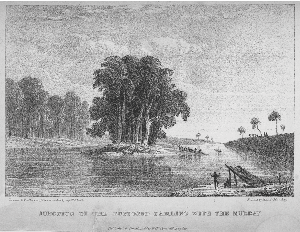Diseases and pathogens sometimes carry the names of places associated with their discovery. For example, some mosquito-borne viruses have been named after the site where the mosquito vectors that yielded the new virus isolate were collected (eg, the Sindbis, Whataroa and Sepik viruses).1-3 Likewise, many rodent-borne viruses are named after the place where the rodents were trapped (eg, the Seoul, Dobrava and Thailand viruses).4 Other well known examples of viruses named after places associated with their discovery include Ebola virus (named after the Ebola River in the Democratic Republic of Congo),5 Lassa virus (after the town of Lassa in Nigeria)6 and Coxsackie virus (after a small town in New York State in the United States).7 There is also a long history of naming new antigenic strains of influenza after the place the specimen was collected. For example, the strains chosen for inclusion in the vaccine for the 2010–2011 northern hemisphere winter season are A/California/7/2009 (H1N1), A/Perth/106/2009 (H3N2), and B/Brisbane/60/2008.8 The names of some bacterial diseases are also derived from placenames. For example, tularaemia (caused by Francisella tularensis) was named after Tulare county in the US, where it was first isolated;9 Lyme disease (caused by Borrelia spp) after the town of Lyme in the US, where cases were identified;10 and Rocky Mountain spotted fever (caused by Rickettsia rickettsii) after the region where it was first identified.11
Train at Hendra Station (the suburb was named after this station)

Photo by D G Bailey, 1967, courtesy of Ken Rogers Memorial Library, Australian Railway Historical Society, Queensland Division
The suburb of Hendra in Brisbane is intimately associated with the history of horseracing in Queensland. With the growing popularity of the sport in the 1800s, Eagle Farm Racecourse was established in Brisbane in 1863. It soon became Queensland’s premier horseracing destination, drawing large crowds.12 To enable easy public access to the racecourse, a railway line, the “racecourse branch”, was established to service the racecourse.13 One of the railway stations on that line, from which the suburb gets its name, was called “Hendra” by Francis Curnow, a Commissioner for Railways, as it reminded him of “a spot in Cornwall of hallowed association”.14 Hendra is an old Cornish name meaning “old place” or “old farm”.15
In September 1994, an outbreak of a lethal, previously unknown virus killed 13 horses associated with a stable in Hendra. Two humans became infected, and one of them died of the disease.16,17 The causative virus was initially named “equine morbillivirus” but subsequently named “Hendra virus”.18 It was the first designated member of a new genus, Henipavirus, of the family Paramyxoviridae. A previous unrelated outbreak was retrospectively diagnosed when a farmer in Mackay (almost 800 kilometres north of Hendra) died after developing severe encephalitis, a year after his initial infection.19,20
The reservoir host of Hendra virus is the fruit bat (Pteropus spp).21 Horses are thought to acquire the disease by ingesting material contaminated with bat urine, saliva, birth products, or the fibrous masticated fruit material called “spats”.21,22 Humans who have acquired the disease have had close contact with secretions of infected horses and have presented with respiratory and/or neurological symptoms.16,19,23 No bat-to-human or human-to-human transmission has been recorded. There have been a further four human cases of Hendra virus infection, with two fatalities (both veterinarians who had close contact with infected horses).
Fishing in the Ross River near Townsville, 1884

Photo courtesy of John Oxley Library, State Library of Queensland (image no. APO-014-0001-0018DTL system no. 234883).
The discovery of Ross River takes us back to the early 19th century, a time when northern Queensland was being populated by European settlers. Among the early settlers was a Scottish entrepreneur called John Black who moved to northern Queensland to join the pastoral rush and established a very successful farm. Because of the high cost of overland transport, Black thought it would be economically advantageous if he could find a port close to his properties. In early 1864, he sent two of his managers to find a suitable port nearby where ships could berth. Most of the shores of the bay were mangroves or rocky headlands and unsuitable for ships, but in their search, they found a narrow river mouth suitable for small ships and with good inland access. They named the newly discovered river after William Alfred Ross, who was a business associate of Black.24,25 The 45 kilometre-long Ross River played a crucial part in the development of northern Queensland.24
In 1928, an “unusual epidemic” of skin eruptions and arthralgia was described at Narrandera, a town near the Murrumbidgee River in New South Wales.26 There were further outbreaks of “epidemic polyarthritis”,27 as this syndrome was later called, during the Second World War.28 In 1959, a group A arbovirus, designated “T48”, was isolated from Aedes vigilax mosquitoes collected from mangroves near the Ross River at Townsville.29 Sera of patients with epidemic polyarthritis had antibodies against the T48 virus, and it was hypothesised to be the causative virus for the disease.29 T48 was subsequently named “Ross River virus” (RRV).30 The virus was first isolated from patients with clinical disease during a large epidemic in the South Pacific during 1979–198028 and subsequently in 1985 from Australian patients with clinical features of the disease.31
RRV, an alphavirus, is the most common arboviral infection found in Australia,3 with 4784 cases notified in 2009 (mostly from Queensland).32 It is maintained in a mosquito–vertebrate host cycle, with native macropods, such as kangaroos and wallabies, thought to be the major vertebrate hosts.33 Infection can be asymptomatic or can cause a self-limiting illness characterised by polyarthralgia and polyarthritis, usually involving joints of the extremities. There can also be fever, maculopapular rash, myalgia and fatigue.28,34
The Mitchell River at Bairnsdale, 1878

Early wood engraving published in Illustrated Australian News, 1878; courtesy of State Library of Victoria.
Bairnsdale is located in Victoria about 280 kilometres east of Melbourne. It was named after a property owned by a pioneer settler, Archibald Macleod. The name “Bairnsdale” is said to have been derived from his grandfather’s village, Bernisdale, on the Isle of Skye in Scotland. It is also said that it got its name because of the large number of babies (“bairns” in Scottish) who were born there.35
In 1948, researchers reported on a series of patients from Bairnsdale who had presented with a disease characterised by unusual ulcers. A new species of Mycobacterium was isolated as the cause of the disease.36 Although the disease had been described in Africa as early as 1897, this was the first time the organism had been isolated.37 It has been known locally as the “Bairnsdale ulcer” and also as “Daintree ulcer” (after an endemic area between Mossman and the Daintree River in northern Queensland).38 Active foci of infection have been reported in coastal Victoria and Queensland.39 It is more commonly known worldwide as the “Buruli ulcer” (after Buruli, Uganda, the site of an early epidemic). It has been reported in at least 30 countries and is an important public health problem, especially in West Africa.37,40
Bairnsdale ulcer is caused by Mycobacterium ulcerans, an acid-fast bacillus. It is an environmental organism and has been found in aquatic insects, but the mode of transmission is unclear.37,40 The most plausible route is thought to be trauma at skin sites contaminated with the organism.40 It presents as an indolent, progressive ulcer that can cause significant morbidity. Treatment is by surgical excision and/or combination antibiotics.37,39,40
Sketch of the Murray River by Captain Charles Sturt (17951869)

Courtesy of State Library of South Australia (http://www.samemory.sa.gov.au/site/page.cfm?u=61&c=3813).
The Murray Valley, located in Victoria, derives its name from the Murray River that runs through it. Starting in the Snowy Mountains, it winds its way for over 2500 kilometres to meet the sea in South Australia41 and is Australia’s longest river. The first Europeans to explore the river were Hamilton Hume and William Hovell in 1824. In 1830, another explorer, Captain Charles Sturt, reached the river by boat after travelling down one of its tributaries and continued further down the river to reach its mouth. He named it the “Murray River” in honour of the British Secretary of State for War and the Colonies, Sir George Murray,42 not realising it was the same river that Hume and Hovell had encountered further upstream and named the “Hume River”.43
Between 1917 and 1925, epidemics of severe encephalitis with a high fatality rate were reported in eastern Australia. The new disease was called “Australian X disease”. An infectious aetiology was evident when it was established, in 1917, that cerebrospinal fluid from human cases could infect animals, producing similar pathology, and that the infection was maintained through multiple intracerebral passages in monkeys.44 There were no further epidemics of encephalitis reported for over 25 years, until cases of a disease similar to Australian X disease were reported in the Murray Valley region in 1950 and 1951. The disease was given the name “Murray Valley encephalitis” (MVE), and the causative virus was independently isolated by Eric French and John Miles.44,45 The clinical, histological and epidemiological features of Australian X disease and MVE appeared to be indistinguishable, and they are thought to be the same disease.44 In 1960, the virus was isolated from Culex annulirostris mosquitoes, its major vector.46
MVE virus is a mosquito-borne virus of the Flaviviridae family, closely related to the Japanese encephalitis virus and West Nile virus. It is maintained in an enzootic cycle between waterbirds and the culicine mosquito vectors.47 Most infections are subclinical, but some may progress to an encephalitis of varying severity.47,48 Since the last major epidemic in 1974, there have been over 75 cases of MVE reported, largely from enzootic areas of Western Australia and the Northern Territory.32,49
Drs Eric French, Gray Anderson and Leslie Frazer standing beside their mobile laboratory during field investigations of the 19501951 outbreak of Murray Valley encephalitis

Photo Eric French; reprinted from Mackenzie JS, Broom AK. Australian X disease, Murray Valley encephalitis and the French connection. Vet Microbiol 1995; 46: 79-90, with permission from Elsevier.
Barmah Forest is a large river red gum forest in Victoria, about 225 kilometres north of Melbourne. The name “Barmah” is derived from the Yorta Yorta Aboriginal language, but its meaning is uncertain.50 It has been suggested that it is derived from the word “paama”, meaning “meeting place”.51 The Barmah region has a rich history of Aboriginal hunting and gathering that was subsequently displaced by European settlement.52
In 1974, an epidemic of encephalitis in the Murray Valley region prompted researchers to collect pools of mosquitoes in the area to characterise the species involved in transmission of MVE. This led not only to the isolation of MVE, but also to the incidental isolation of 10 other arboviruses, among which was isolate BH2193, collected from mosquitoes trapped in the Barmah Forest area. This new and previously undescribed virus was subsequently named “Barmah Forest virus” (BFV).53 Around the same time, a new virus was isolated in central Queensland and named “Murweh virus” after the local shire of Murweh,54 but was later found to be a strain of BFV. The first reported human infection with BFV was in 1986,55 and the first epidemic due to BFV occurred in the NT in 1992.56
BFV, an alphavirus related to RRV, is the second most common arboviral infection in Australia, with 1487 cases notified in 2009.32 Several mosquito species are able to transmit BFV, but little is known of the vertebrate hosts.3,57,58 BFV infection causes a similar illness to that caused by RRV, with symptoms including arthralgia, myalgia, fever and rash. Subclinical infection is common.59
There are a number of other diseases and pathogens named after places in Australia. “Flinders Island spotted fever”, a rickettsial disease caused by Rickettsia honei, was first recognised on Flinders Island in the Bass Strait.60 “Queensland tick typhus”, caused by Rickettsia australis, affected soldiers training in Queensland during the Second World War,61,62 and “Mossman fever” was used to describe febrile illness (caused by a number of diseases, such as scrub typhus, malaria and leptospirosis) in early European settlers of northern Queensland.61 Places whose names have been associated with human viral infections include Trubanaman (the original name of Mitchell River Mission); Edge Hill and Stratford (both suburbs in Cairns); and Menangle (a suburb in Sydney).3,46,63,64 Australian bat lyssavirus also comes under this category.65 Others, like Wallal and Warrego viruses66 (isolated in south-western Queensland and named after geographical features, such as the Warrego River), have affected wildlife. Two other viruses, Kokobera virus and Kunjin virus (a strain of West Nile virus), also occasional human pathogens, have been named after Aboriginal tribes around Mitchell River Mission, where they were first isolated (Ralph Doherty, former Director, Queensland Institute of Medical Research, personal communication).
The naming of diseases after places has been controversial at times. Although some regard it as a testament to the medical research conducted in a region,24 others haven’t taken such naming lightly. For example, in 1993, a new hantavirus was isolated by the US Centers for Disease Control and Prevention and the name “Four Corners virus” or “Muerto Canyon virus” was suggested. However, after objections by the local residents, the virus was subsequently named “Sin Nombre virus” — “sin nombre” meaning “without a name” in Spanish.67
The 1974 epidemic of MVE was an example of a disease name creating bad publicity that had a negative effect on tourism and trade in the Murray Valley region. There were even stories of motorists at petrol stations refusing to get out of their cars (to avoid being bitten by mosquitoes) and passing bank notes for payment through the top of the car window, and of fruit pickers refusing to work there for fear of infection. To circumvent these problems, there were suggestions that the name “Australian encephalitis” could be used, but this was not widely accepted. In Queensland, a suggestion to call a newly described rickettsial infection (caused by Coxiella burnetii) “Queensland rickettsial fever” was unpopular given its potential impact on tourism. It was instead called “Q fever” (Q referring now to “query”).68
Such reactions are not surprising because, apart from denoting and identifying human habitation sites, geographic features and political boundaries, toponyms are a medium that provides public and personal reference.69 People have strong attachments to placenames because they are linking agents or symbols of attachment between themselves and a place.
- Ranil D Appuhamy1
- Jan Tent2,3
- John S Mackenzie4,5
- 1 Health Protection Directorate, Queensland Health, Brisbane, QLD.
- 2 Department of Linguistics, Macquarie University, Sydney, NSW.
- 3 Australian National Placenames Survey, Macquarie University, Sydney, NSW.
- 4 Faculty of Health Sciences, Curtin University, Perth, WA.
- 5 Burnet Institute, Melbourne, VIC.
We would like to thank Professor Ralph Doherty for providing information about the Australian arboviruses.
None identified.
- 1. Taylor RM, Hurlbut HS, Work TH, et al. Sindbis virus: a newly recognized arthropod transmitted virus. Am J Trop Med Hyg 1955; 4: 844-862.
- 2. Maguire T, Miles JA, Casals J. Whataroa virus, a group A arbovirus isolated in South Westland, New Zealand. Am J Trop Med Hyg 1967; 16: 371-373.
- 3. Mackenzie JS, Lindsay MD, Coelen RJ, et al. Arboviruses causing human disease in the Australasian zoogeographic region. Arch Virol 1994; 136: 447-467.
- 4. Klein SL, Calisher CH. Emergence and persistence of hantaviruses. Curr Top Microbiol Immunol 2007; 315: 217-252.
- 5. Pourrut X, Kumulungui B, Wittmann T, et al. The natural history of Ebola virus in Africa. Microbes Infect 2005; 7: 1005-1014.
- 6. Frame JD, Baldwin JM Jr, Gocke DJ, Troup JM. Lassa fever, a new virus disease of man from West Africa. I: clinical description and pathological findings. Am J Trop Med Hyg 1970; 19: 670-676.
- 7. Dalldorf G, Gifford R. Clinical and epidemiological observations of Coxsackie-virus infection. N Engl J Med 1951; 244: 868-887.
- 8. World Health Organization. Recommended viruses for influenza vaccines for use in the 2010–2011 northern hemisphere influenza season. Feb 2010. http://www.who.int/csr/disease/influenza/201002_Recommendation.pdf (accessed Aug 2010).
- 9. Tärnvik A, Berglund L. Tularaemia. Eur Respir J 2003; 21: 361-373.
- 10. Steere AC, Malawista SE, Snydman DR, et al. Lyme arthritis: an epidemic of oligoarticular arthritis in children and adults in three Connecticut communities. Arthritis Rheum 1977; 20: 7-17.
- 11. Thorner AR, Walker DH, Petri WA. Rocky Mountain spotted fever. Clin Infect Dis 1998; 27: 1353-1360.
- 12. Coughlan H, Pascoe N. Queensland Turf Club: a place in history. Brisbane: Boolarong Press, 2009.
- 13. Kerr J. Brunswick Street, Bowen Hills and beyond: the railways of the northern suburbs of Brisbane. Brisbane: Australian Railway Historical Society, 1988.
- 14. May S. Queensland place names. Local Government 1959; Feb: 25-29.
- 15. Holmes J. 1000 Cornish place names explained. Exeter, UK: Short Run Press, 1983.
- 16. Murray K, Rogers R, Selvey L, et al. A novel morbillivirus pneumonia of horses and its transmission to humans. Emerg Infect Dis 1995; 1: 31-33.
- 17. Selvey L, Wells R, McCormack J, et al. Infection of humans and horses by a newly described morbillivirus. Med J Aust 1995; 162: 642-644.
- 18. Halpin K, Mungall B. Recent progress in henipavirus research. Comp Immunol Microbiol Infect Dis 2007; 30: 287-307.
- 19. O’Sullivan JD, Allworth AM, Paterson DL, et al. Fatal encephalitis due to novel paramyxovirus transmitted from horses. Lancet 1997; 349: 93-95.
- 20. Baldock FC, Douglas IC, Halpin K, et al. Epidemiological investigations into the 1994 equine morbillivirus outbreaks in Queensland, Australia. Singapore Vet J 1996; 20: 57-61.
- 21. Halpin K, Young PL, Field HE, Mackenzie JS. Isolation of Hendra virus from pteropid bats: a natural reservoir of Hendra virus. J Gen Virol 2000; 81: 1927-1932.
- 22. Field HE, Mackenzie JS, Daszak P. Henipaviruses: emerging paramyxoviruses associated with fruit bats. Curr Top Microbiol Immunol 2007; 315: 133-159.
- 23. Playford EG, McCall B, Smith G, et al. Human Hendra virus encephalitis associated with equine outbreak, Australia, 2008. Emerg Infect Dis 2010; 16: 219-223.
- 24. Bell P. History of Ross River. Thuringowa: Thuringowa City Council, 2003. (Library Heritage Services Lecture Series No 1.)
- 25. Queensland Government. Property, titles and valuations. http://www.nrw.qld.gov.au/property/placenames (accessed Dec 2009).
- 26. Nimmo JR. An unusual epidemic. Med J Aust 1928; 1: 549-550.
- 27. Dowling PG. Epidemic polyarthritis. Med J Aust 1946; 1: 245-246.
- 28. Harley D, Sleigh A, Ritchie S. Ross River virus transmission, infection and disease: a cross disciplinary review. Clin Microbiol Rev 2001; 14: 909-932.
- 29. Doherty RL, Whitehead RH, Gorman BM. Isolation of a third group A arbovirus in Australia with preliminary observations on its relationship to epidemic polyarthritis. Aust J Sci 1963; 26: 183-184.
- 30. Doherty RL. Ross River virus. In: Taylor RM, editor. Catalogue of arthropod borne viruses of the world. Washington, DC: US Department of Health, Education and Welfare, 1967: 421-424. (Public Health Service publication 1760.)
- 31. Aaskov JG, Ross PV, Harper JJ, Donaldson MD. Isolation of Ross River virus from epidemic polyarthritis patients in Australia. Aust J Exp Biol Med Sci 1985; 63: 587-597.
- 32. Australian Department of Health and Ageing. National notifiable diseases surveillance system. http://www9.health.gov.au/cda/source/cda-index.cfm (accessed Aug 2010).
- 33. Russell R. Ross River virus: ecology and distribution. Annu Rev Entomol 2002; 47: 1-31.
- 34. Suhrbier A, La Linn M. Clinical and pathologic aspects of arthritis due to Ross River virus and other alphaviruses. Curr Opin Rheumatol 2004; 16: 374-379.
- 35. Kennedy B, Kennedy B. Australian placenames. Sydney: Hodder and Stoughton, 1988.
- 36. MacCallum P, Tolhurst JC, Buckle G, Sissons H. A new mycobacterial infection in man. J Pathol Bacteriol 1948; 60: 93-122.
- 37. Van der Werf TS, Stienstra Y, Johnson RC, et al. Mycobacterium ulcerans disease. Bull World Health Organ 2005; 83: 785-791.
- 38. Jenkin GA, Smith M, Fairley M, Johnson PD. Acute, oedematous Mycobacterium ulcerans infection in a farmer from far north Queensland. Med J Aust 2002; 176: 180-181. <MJA full text>
- 39. Johnson PD, Hayman JA, Quek TY, et al. Consensus recommendations for the diagnosis, treatment and control of Mycobacterium ulcerans infection (Bairnsdale or Buruli ulcer) in Victoria, Australia. Med J Aust 2007; 186: 64-68. <MJA full text>
- 40. Walsh DS, Portaels F, Meyers WM. Buruli ulcer (Mycobacterium ulcerans infection). Trans R Soc Trop Med Hyg 2008; 102: 969-978.
- 41. Mackay N, Eastburn D, editors. The Murray. Canberra: Murray Darling Basin Commission, 1990.
- 42. Sturt C. Two expeditions into the interior of Southern Australia during the years 1828, 1829, 1830, 1831, with observations on the soil, climate and general resources of the colony of New South Wales. London: Smith Elder and Co, 1833.
- 43. Clark CM. A history of Australia. Vol II: New South Wales and Van Diemen’s Land, 1822–1838. Melbourne: Melbourne University Press, 1968.
- 44. Mackenzie JS, Broom AK. Australian X disease, Murray Valley encephalitis and the French connection. Vet Microbiol 1995; 46: 79-90.
- 45. French EL. A review of arthropod-borne virus infections affecting man and animals in Australia. Aust J Exp Biol Med Sci 1973; 51: 131-158.
- 46. Doherty RL, Carley JG, Mackerras MJ, Marks EN. Studies of arthropod borne virus infections in Queensland. III. Isolation and characterization of virus strains from wild-caught mosquitoes in North Queensland. Aust J Exp Biol Med Sci 1963, 41: 17-39.
- 47. Marshall ID. Murray Valley and Kunjin encephalitis. In: Monath TP, editor. The arboviruses: epidemiology and ecology. Vol III. Boca Raton, Fla: CRC Press, 1988.
- 48. Broom AK, Lindsay MD, Plant AJ, et al. Epizootic activity of Murray Valley encephalitis virus in an Aboriginal community in the southeast Kimberley region of Western Australia: results of cross-sectional and longitudinal serologic studies. Am J Trop Med Hyg 2002; 67: 319-323.
- 49. Spencer JD, Azoulas J, Broom AK, et al. Murray Valley encephalitis virus surveillance and control initiatives in Australia. Commun Dis Intell 2001; 25: 33-47.
- 50. Bowe H, Morey S. The Yorta Yorta (Bangerang) language of the Murray Goulburn: including Yabula Yabula. Canberra: Pacific Linguistics, Australian National University, 1999.
- 51. Blake LB. Place names of Victoria. Melbourne: Rigby, 1977.
- 52. Fahey C. Barmah Forest — a history. Melbourne: Department of Conservation, Forests and Lands, 1988.
- 53. Marshall ID, Woodroofe GM, Hirsch S. Viruses recovered from mosquitoes and wildlife serum collected in the Murray Valley of south-eastern Australia, February 1974, during an epidemic of encephalitis. Aust J Exp Biol Med Sci 1982; 60: 457-470.
- 54. Doherty RL, Carley JG, Kay BH, et al. Isolation of virus strains from mosquitoes collected in Queensland, 1972–1976. Aust J Exp Biol Med Sci 1979; 57: 509-520.
- 55. Vale TG, Carter IW, McPhie KA, et al. Human arbovirus infections along the south coast of New South Wales. Aust J Exp Biol Med Sci 1986; 64: 307-309.
- 56. Merianos A, Farland AM, Patel M, et al. A concurrent outbreak of Barmah Forest and Ross River virus disease in Nhulunbuy, Northern Territory. Commun Dis Intell 1992; 16: 110-111.
- 57. Jacups SP, Whelan PI, Currie BJ. Ross River virus and Barmah Forest virus infections: a review of history, ecology and predictive models, with implications for tropical Northern Australia. Vector Borne Zoonotic Dis 2008; 8: 283-297.
- 58. Russell RC. Vectors vs. humans in Australia — who is on top down under? An update on vector-borne disease and research on vectors in Australia. J Vector Ecol 1998; 23: 1-46.
- 59. Phillips DA, Murray JR, Aaskov JG, Weimers MA. Clinical and subclinical Barmah Forest virus infection in Queensland. Med J Aust 1990; 152: 463-466.
- 60. Stewart RS. Flinders Island spotted fever: a newly recognised endemic focus of tick typhus in Bass Strait. Part 1: clinical and epidemiological features. Med J Aust 1991; 154: 94-99.
- 61. Graves S, Stenos J. Rickettsioses in Australia. Ann N Y Acad Sci 2009; 1166: 151-155.
- 62. Andrews R, Bonnin JM, Williams S. Tick typhus in north Queensland. Med J Aust 1946; 2: 253-258.
- 63. Boughton CR, Hawkes RA, Naim HM. Arbovirus infection in humans in NSW: seroprevalence and pathogenicity of certain Australian bunyaviruses. Aust N Z J Med 1990; 20: 51-55.
- 64. Chant K, Chan R, Smith M, et al. Probable human infection with a newly described virus in the family Paramyxoviridae. Emerg Infect Dis 1998; 4: 273-275.
- 65. Hanna JN, Carney IK, Smith GA, et al. Australian bat lyssavirus infection: a second human case, with a long incubation period. Med J Aust 2000; 172: 597-599. <MJA full text>
- 66. Hooper PT, Lunt RA, Gould AR, et al. Epidemic blindness in kangaroos — evidence of a viral aetiology. Aust Vet J 1999; 77: 529-536.
- 67. Strauss JH, Strauss EG. Viruses and human disease. 2nd ed. London: Elsevier, 2008.
- 68. Burnet FM. Changing patterns: an atypical autobiography. Melbourne: William Heinemann, 1968.
- 69. Altman I, Low SM, editors. Place attachment. New York: Plenum Press, 1992.





Abstract
Names are more than just labels used to identify diseases. They can be windows into the discovery, characteristics and attributes of the disease.
Toponymous diseases are diseases that are named after places.
Hendra, Ross River, Bairnsdale, Murray Valley and Barmah Forest are all examples of Australian places that have had diseases named after them. They all have unique and interesting stories that provide a glimpse into their discovery, history and culture.
Because of perceived negative connotations, the association of diseases with placenames has sometimes generated controversy.